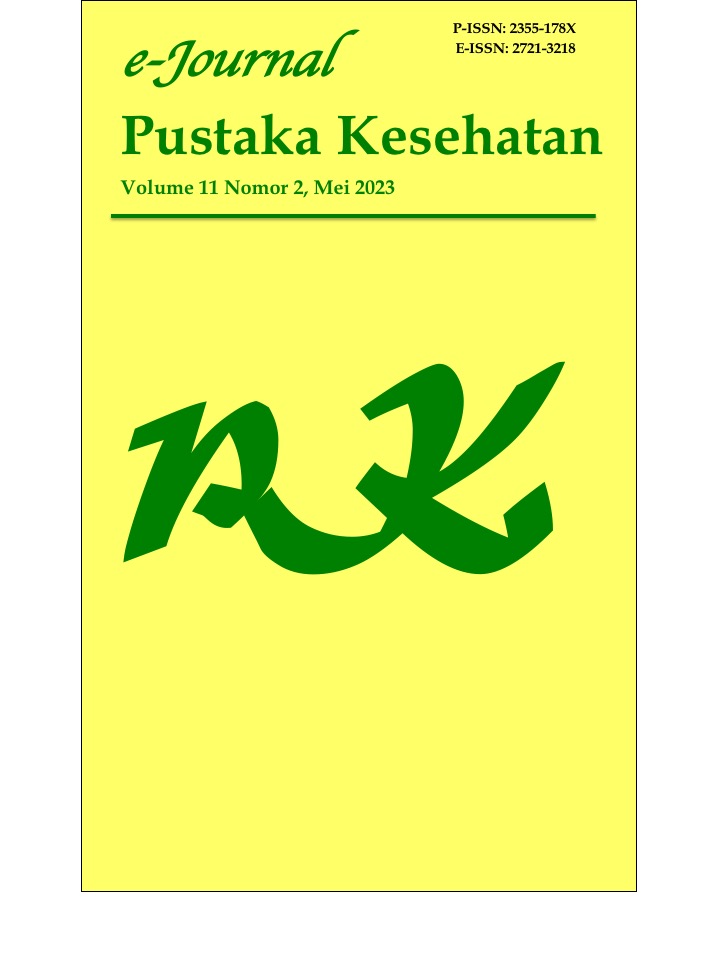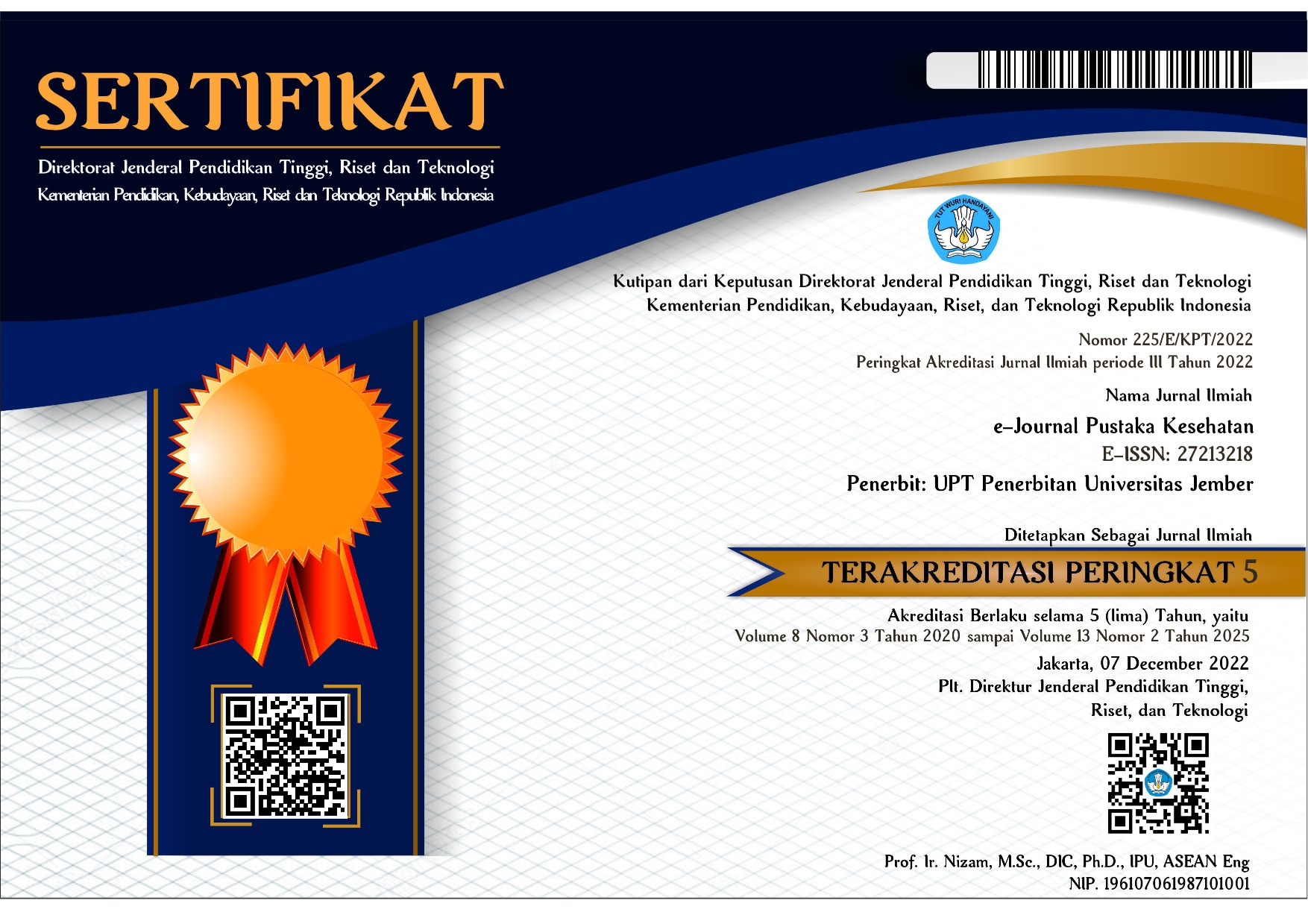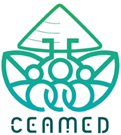Hubungan Sedentary Lifestyle dengan Status Gizi Remaja pada Masa Pandemi Covid-19 di SMPN 14 Jember
DOI:
https://doi.org/10.19184/pk.v11i2.37128Keywords:
sedentary lifestyle; over nutrition status; nutrition status; adolescentsAbstract
More nutritional status occurs because of an imbalance between energy intake and energy expenditure. High energy intake is the result of excessive food consumption, while low energy expenditure is the result of a lack of physical activity. The sedentary lifestyle has increased during the Covid-19 Pandemic. Sedentary lifestyle triggers the risk of overweight and obesity in adolescents. This research uses an analytic observational design with a cross-sectional approach which aims to determine the relationship between sedentary lifestyle and nutritional status of adolescents. Respondents in this study were adolescents aged 13-15 years. The number of samples was 70 respondents used purposive sampling technique. The instrument used was the Adolescent Sedentary Activity Questionnaire (ASAQ) and measurement of nutritional status using standard anthropometric z-score tables to assess nutritional status in children aged 5-18 years. This study obtained the results of the Spearman rank test, obtained a p-value of 0.000 (<0.05) and a correlation coefficient of 0.470, which means that there is a significant and unidirectional relationship with moderate strength between the sedentary lifestyle and the nutritional status of adolescents. It can be concluded that with increasing sedentary lifestyle, nutritional status will also increase. Sedentary lifestyle is a factor associated with overweight status because low physical activity causes fat accumulation due to not burning calories.
Downloads
References
[2] Hyunrah J, Boonsta A, Agustina R, Zutphen KG, et al. The Triple Burden of Malnutrition Among Adolescents in Indonesia. Food and Nutrition Bulletin. 2021; 42(IS): S4-S8.
[3] Gebreyohannes Y, Shiferaw S, Dimstu B,Bugssa G. Nutritional status of adolescents in selected government and private secondary schools of addis ababa, ethiopia. International Journal of Nutrition and Food Sciences. 2014; 3(6): 504.
[4] Abeng AT. Faktor aktivitas fisik terhadap status gizi siswa di sma negeri 2 kota palangka raya. Jurnal Ilmiah Kesehatan. 2020; 12(1): 84–90.
[5] Dieny FF. Permasalahan Gizi Pada Remaja Putri. Yogyakarta: Graha ilmu; 2014.
[6] Handari SR, Loka T. Hubungan aktivitas fisik dan kebiasaan konsumsi fast food dengan status gizi lebih remaja sma labschool kebayoran baru jakarta selatan tahun 2016. Jurnal Kedokteran Dan Kesehatan. 2017; 13(2): 153-160.
[7] UNICEF Indonesia [Internet]. Profil Remaja 2021; 2021 [cited 2022 Februari 17]. Available from: https://www.unicef.org/indonesia/id/laporan/profil-remaja
[8] Riset Kesehatan Dasar [internet]. Laporan Nasional Riskesdas 2018; 2018 [cited 2022 Februari 17]. Badan Penelitian dan Pengembangan Kesehatan Kementerian Kesehatan RI.
[9] Rohmah MH, Rohmawati N, Sulistiyani S. Hubungan kebiasaan sarapan dan jajan dengan status gizi remaja di sekolah menengah pertama negeri 14 jember. Ilmu Gizi Indonesia. 2020; 4(1): 39-50.
[10] Kemenkes RI [internet]. Pemerintah Tidak Terburu-Buru Melakukan Transisi dari Pandemi ke Endemi; 2022 [cited 2022 Februari 20]. Available from: https://sehatnegeriku.kemkes.go.id/baca/rilismedia/20220315/1539530/pemerintah-tidak-terburu-buru-melakukan-transisi-dari-pandemi-ke-endemi/
[11] Fitria S, Surya D. The impact of covid-19 pandemic on students’ sedentary behavior in indonesia. Jurnal Serambi Ilmu. 2021; 22(1): 88–97. W
[12] WHO [internet]. Obesity and overwheight; 2021 [cited februari 20]. Available from: https://www.who.int/news-room/fact-sheets/detail/obesity-and-overweight
[13] Fitriani A, Setyowati YD, Arumsari I. Peningkatan pengetahuan dan perilaku aktifitas fisik siswa sekolah dasar melalui edukasi berbasis praktik. Jurnal Masyarakat Mandiri. 2020; 4(4): 6–9.
[14] Lestari M, Nurhayati. Hubungan Antara Aktivitas Sedentari Dengan Prevalensi Overweight. Jurnal Pendidikan Olahraga dan Kesehatan. 2018; 6(2): 369-373.
[15] Mandriyarini R, Sulchan M, Nissa C. Sedentary lifestyle sebagai risiko kejadian obesitas pada remaja SMA stunted di Kota Semarang. Journal of Nutrition College. 2017; 6(2): 149-155.
[16] Sholihah M. Pengembangan Model Peran Keluarga Terhadap Sedentary Lifestyle Remaja berbasis Family Cantered Nursing dan Theory of Planned Behavior. Program Studi Magister keperawatan Fakultas Keperawatan Universitas Airlangga, Surabaya. 2019.
[17] Markuri TD. Hubungan Aktivitas Fisik Dengan Status Gizi Siswa SMKN 03 Kabupaten Muko-Muko Pada Mas Pandemi Covid-19. Arsip Gizi dan Pangan. 2021; 6(2): 122-130.
[18] Rahma EN, Wirjatmadi B. Hubungan antara aktivitas fisik dan aktivitas sedentari dengan status gizi lebih pada anak sekolah dasar. Amerta Nutrition. 2020; 4(1): 79-84.
[19] Rahmad AH. Sedentari sebagai faktor kelebihan berat badan remaja. Jurnal Vokasi Kesehatan. 2019; 5(1): 16-21.
[20] Yulia C, Khomsan A, Sukandar D, Riyadi H. Nutritional status, physical activity, sedentary activity of school children in urban area, west java, indonesia. Jurnal Gizi Dan Pangan. 2018; 13(3): 123–130.
[21] Vazquez F. Assocition between family structure, maternal education level, and maternal ewmployment with sedentary lifestyle in primary school-age children. Jornal de Pediatria. 2013; 89(2): 145-150.
[22] Potter, Perry. Buku Ajar Fundamental Keperawatan. Volume 1 edisi 4. Jakarta: EWGC; 2005.
[23] Syahfitri Y, Ernalia Y, Restuastuti T. Gamabaran Status Gizi Siswa Siswi SMP Negeri 13 Oekanbaru Tahun 2017. JOM FK. 2018; 4(1): 1-12.
[24] Ha-Park J, Moon JH, Kong MH, Kim HJ. Sedentary Lifestyle: Overview of Updated Evidence of Potential Health Risk. Korean Journal of Family Medicine. 2020; 41(6): 365-373.
[25] Rompas KF. Hubungan antara sosial ekonomi keluarga dengan status gixi pada pelajar di SMP wilayah Kecamatan Malalayang 1 Kota Manado. Jurnal Imiah Farmasi. 2018; 5(4):225-233.
[26] Suryani IS, Sulastri M, Hasrinurhidayat. Hubungan Komsumsi Junk Food Dengan Status Gizi Pada Remaja di Sekolah Menengah Pertama. Jurnal Keperawatan dan Kebidanan. 2020 4(1): 79-84.
[27] Junaidi, Noviyandi. Kebiasaa komsumsi fast food terhadap obesitas pada anak sekolah dasar Banda Aceh. Aceh Nutrition Journal. 2017; 1(2): 78-82.
[28] Sofiany IR, Setyawati MI. Potrait of The Sedentary Lifestyle Among Students From Public Health School. Muhammadiyah Jurnal Epidemiologi. 2021; 1(1): 65-72.
[29] Amini AZ. Sedenatry lifestyle sebagai faktor risiko obesitas pada remaja SMP Stunting usia 12-15 tahun. Fakultas Kedokteran Universitas Diponegoro. 2017.
[30] Leonardo C, Dese DC. Gambaran Status Gizi dan Aktivitas Fisik Remaja Selama Pandemi Covid-19. Jurnal Keperawatan Muhammadiyah. 2021; 6(4): 79-84.
[31] Steffen N, Zemel BS, Kumanyika S, Stallings VA. Infant Weight Gain and Chilhood Overweight Status in a Multicenter, Cohort Study. Journal of The American Academy of Pediatrics. 2019; 20(109): 94-109.
[32] Novalina R, Zahtamal, Primayuni Y. Perilaku aktivitas fisik terhadap kejadian gizi lebih pada anak usia sekolah dasar di SDN 018 Desa Kubang Jaya Kabupaten Kampar Tahun 2018. Jurnal Ilmu Kesehatan Masyarakat. 2019; 8(1): 48-55.
[33] Zarei M, Taib MN, Zarei F, Saad AH. Faktors Associated with body weight status of Iranian Postgraduate Students in University of Putra Malaysia. Nurs Midwifery Stud. 2019; 2(4): 97-102.
[34] Braude L, Stevenson RJ. Wathcing television while eating increases energy intake. Journal Appetite. 2018; 76: 9-16.
[35] Deschasaux-Tanguy M. Diet and physical activity during the Covid-19 lockdown period. the French NutrNet-Sante cohort study. 2020; 113(4): 924-938
[36] Mcormac GR, Baker PKD, Petersen JA, Ghoneim D. Parent anxiety and perceptions of their child;s physical activity and sedentary behaviour during the Covid-19 Pandemic in Canada. Journal Pre-proofs. 2020; 20: 1-18.
Downloads
Published
Issue
Section
License
e-Journal Pustaka Kesehatan has CC-BY-SA or an equivalent license as the optimal license for the publication, distribution, use, and reuse of scholarly work. Authors who publish with this journal retain copyright and grant the journal right of first publication with the work simultaneously licensed under a Creative Commons Attribution-ShareAlike 4.0 International License that allows others to share the work with an acknowledgment of the work's authorship and initial publication in this journal.







